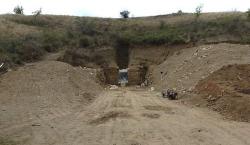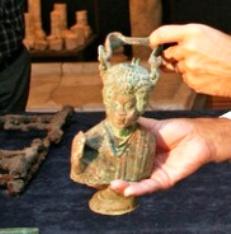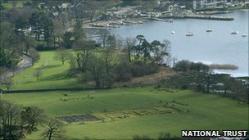- 23 JUIN
- INDI-UNI : 
PRE-INSCRIPTION : 15 Juin – 15 Août
PRE-REGISTRATION: June 15th - August 15th
- EGYPTE – Amhada - A huge palace from the Roman ages (31-395 BC) has been discovered in the New Valley Governorate in Upper Egypt. An US expedition in the Amhada region, 500km south of Cairo, unearthed a palace belonging to a person named Sornius, according to a statement by the ministry. The ministry said the palace cannot be opened to the public due to erosion, but it said a copy will be constructed for visitors. It added that the US team was able to translate the inscriptions found in the palace, which helped elucidate ancient cultural and educational activities in the region. The team's findings suggested that ancient Egyptian farmers might have worked in the region of the oases before coming to the Nile Valley.
http://www.almasryalyoum.com/en/node/469838
- CHINE – Heze - Les archéologues ont mis à jour ce qui semble être une tombe royale de la dynastie des Han de l'ouest. La découverte de cette tombe vieille de 2 000 ans a eu lieu dans la ville de Heze située dans la province du Shandong. Mesurant 29 mètres de long sur 28 de large, la tombe a été découverte près du lac Lingsheng dans le disctrict de Dingtao. L'équipe d'archéologues a été surprise de découvrir lors des fouilles, des empilements de briques entourant la tombe. Celles-ci sont gravées de motifs ou de caractères chinois de différents styles. Les caractères ont gardé leur couleur rouge claire malgré les 2 millénaires qui se sont écoulés. Afin de protéger leur pigmentation de l'oxydation, les archéologues ont enveloppé et numéroté chaque brique. Selon toute vraisemblance, la tombe appartiendrait à Liu Kang, Prince Gong de la Dynastie des Han de l'ouest.
http://french.people.com.cn/Culture/7418591.html
- USA – Monocacy - Cotton, along with five other Howard students, joined excavations under way at Monocacy National Battlefield, as part of a two-week-long field school. Their goal is to help National Park Service archaeologists and interns broaden their understanding of an unusually large slave village once housed on a plantation called L'Hermitage, now known as the Best Farm. Cotton sifted the first dirt layer on a section of what archaeologists believe may have been a garden plot or enclosure for small animals. The enclosure was kept behind a row of six dwellings used by enslaved people at L'Hermitage in the late 18th to early 19th centuries. Joy Beasley, cultural resources manager for the National Park Service at the battlefield, conducted initial excavations at L'Hermitage in 2003, and oversaw work there last summer. The Vincendieres, a family of French planters who fled Saint-Domingue (Haiti) in 1793 amid rumblings before the Western Hemisphere's first slave revolt, established outside of Frederick what grew into a 748-acre plantation at its peak. By 1800, the Vincendieres had amassed about 90 slaves, making them the second-largest slaveholders in the county. At the time, the family was known locally for their cruel treatment of their slaves. Last summer, Beasley's team delineated the foundations of six houses associated with the slave village and the enclosure. This summer, her team plans to fully excavate one of the roughly 700-square-foot dwellings, the enclosure and a second refuse heap or midden, Beasley said. She is hoping to uncover some of the mysteries about those who lived as slaves on L'Hermitage, including why the Vincendieres held many more slaves than typically used for the sort of grain farming done on the plantation. Beasley is also working in parallel with a genealogist to track down what happened to the enslaved people who lived at L'Hermitage and their ancestors. They have already learned some of L'Hermitage's slaves had been baptized, Beasley said. The Vincendieres were Catholic, and this may help explain why a burial site for the plantation's slaves has yet to be discovered -- perhaps they were buried on consecrated ground elsewhere in Frederick, she said. Researchers also found more advertisements requesting information on the whereabouts of slaves who had fled L'Hermitage, bringing the known number of runaways to four or five, she said. These advertisements can also provide valuable information about these people, including their names and other descriptions. Beasley said the Vincendieres brought 12 slaves with them from Haiti, but does not know where the rest were purchased.
http://www.therepublic.com/view/story/49628a07916b4dc7aa2360da76f21a56/MD--Slave-Village/
- USA – Greensboro - Charlie Gait hurriedly showed ranger Julia Greer what he described as the bottom of a bowl or teacup that he uncovered Wednesday at the Guilford Courthouse National Military Park. But it’s not the most exciting object that Gait, a UNCG senior archaeology major, said he’d found in an archaeological dig. “More importantly, we found a lot of bone — pig and horse bone,” Gait said. Those pigs and horses could have been part of the small community that included the old Guilford Courthouse — the structure the students have been searching for in the past month. UNCG faculty and students last month began excavating at the Revolutionary War battlefield. They found what they believe is a wall from a building, possibly the original courthouse. The courthouse was the American Continental Army’s headquarters during a Revolutionary War battle between the forces of Gen. Nathanael Greene and Lord Charles Cornwallis. Future President Andrew Jackson practiced law at the courthouse in the early part of his career. President George Washington visited the battlefield in 1791. The courthouse was part of a village that sprouted after the war. The village of Martinville, named in honor of former Gov. Alexander Martin, died out after Martin’s death in 1807
http://www.news-record.com/content/2011/06/22/article/unearthing_history
- ROYAUME UNI – Exmoor - An ancient boundary stone has been re-erected after it was spotted by a West landowner. Chris Binnie noticed the stone, some four feet long, hidden under molinia grass while out walking on Porlock Allotment on Exmoor. Mr Binnie contacted the National Park office where arrangements were made for South West Archaeology to carry out a small archaeological excavation and the National Park field services team re-erected it. The area known as the Royal Forest of Exmoor has dominated the Exmoor landscape for nearly 1000 years and for much of that time was owned by the King who marked the boundary of his land. It functioned as a larder for the needs of the Crown and Royal Court as well as becoming a valuable source of income through headage payments for masses of livestock which were grazed there from all around Exmoor during the summer months. The area was subject to Forest Law and during the medieval period this was strongly enforced. The boundary of the Forest became very important at this time and was regularly perambulated to ensure that it was being respected. Many of the boundary markers such as ancient barrows, standing stones, trees and other natural features, can still be found today and are an important legacy of this time.
http://www.thisissomerset.co.uk/Ancient-stone-local-landowner-Exmoor/story-12820163-detail/story.html
- BULGARIE – 
 Opaka - Ancient Thracian golden and bronze finds have been excavated by archaeologists in the town of Opaka, district Turgovishte, in northeastern Bulgaria. During excavations of the grave park, scientists found a preserved Thracian tumulus from 2nd century CE full of rich funeral artifacts. The sites yielded unique discoveries - six leaves of a golden wreath and bronze figurines - and provided more proof of the continued importance of the town of Opeka in northeastern Bulgaria. "The man buried must have been a prominent and wealthy Thracian public figure. As these golden and bronze jewellery and figurines are put only in the graves of the richest," archaeologist and historian Stamen Stanev from Popovo History Museum told bTV. The body in the grave was burnt but the funeral objects around it had been preserved - glass, bronze and ceramic artifacts. Archaeologists believe that all these funeral objects had been imported from abroad. There were two ancient Thracian towns near the newly found tumulus, which altogether form a larger tumulus acropolis. All findings will be restored and transferred to a museum.
Opaka - Ancient Thracian golden and bronze finds have been excavated by archaeologists in the town of Opaka, district Turgovishte, in northeastern Bulgaria. During excavations of the grave park, scientists found a preserved Thracian tumulus from 2nd century CE full of rich funeral artifacts. The sites yielded unique discoveries - six leaves of a golden wreath and bronze figurines - and provided more proof of the continued importance of the town of Opeka in northeastern Bulgaria. "The man buried must have been a prominent and wealthy Thracian public figure. As these golden and bronze jewellery and figurines are put only in the graves of the richest," archaeologist and historian Stamen Stanev from Popovo History Museum told bTV. The body in the grave was burnt but the funeral objects around it had been preserved - glass, bronze and ceramic artifacts. Archaeologists believe that all these funeral objects had been imported from abroad. There were two ancient Thracian towns near the newly found tumulus, which altogether form a larger tumulus acropolis. All findings will be restored and transferred to a museum.
http://www.sofiaecho.com/2011/06/23/1111355_archaeology-new-thracian-grave-found-in-northeastern-bulgaria
- ROYAUME UNI –  Ambleside Fort - Experts are planning to record and protect exposed Roman masonry at a fort in south Cumbria. The aim of the work is to conserve and protect the exposed Roman masonry and show the building foundations inside the fort to enable visitors to understand the archaeology of the site.
Ambleside Fort - Experts are planning to record and protect exposed Roman masonry at a fort in south Cumbria. The aim of the work is to conserve and protect the exposed Roman masonry and show the building foundations inside the fort to enable visitors to understand the archaeology of the site.
http://www.bbc.co.uk/news/uk-england-cumbria-13872918